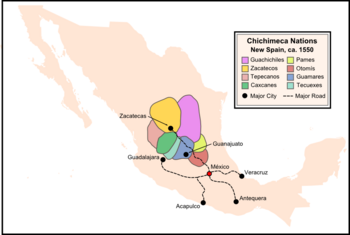Chichimec
Under Chichimeken , the inhabitants of the high valley of Mexico summarized population groups who lived north of the high valley, used Uto-Aztec languages related to the Nahuatl and were considered uncivilized, i.e. not directly part of the culture of Mesoamerica . Until they were established in Mexico, the Aztecs who immigrated late from the north also fell into this group.
etymology
The meaning of the name is unknown. It may originally come from a language other than Nahuatl , as pointed out by Fernando de Alva Ixtlilxóchitl, who came from the Texcoco royal family, at the beginning of the 17th century . The name is possibly a derivation from an unproven place name Chichiman , which corresponds to the Nahuatl word formation rules ; a connection with the Nahuatl verb chichi ("to suck") is conceivable or existed as a folk etymology among the speakers of Nahuatl.
On the one hand, it means people who lived in the north and were of a different culture than those in the high valley. For the Taraskan region , the term Chichimec meant next to the term for distant foreigners, on the other hand, for migrants living in the Taraskan society, who had settled again and still had an acculturation ahead of them. According to the Franciscan Bernardino de Sahagún , the Aztecs described the Chichimecs by certain differences. In addition to language, these were clothing, eating habits, a sense of order and moderation. He also counted cleanliness, the types of weapons and the possession of urban attributes such as buildings and books to the criteria that differentiated an Aztec from a Chichimec.
history
The origins of the Chichimec go back to the 7th century. During this time, like the Toltecs , they pushed further south and came to Guatemala and Nicaragua .
The Chichimecs are also seen as "forerunners" of the Aztecs. In contrast to the Toltecs, who had pronounced artistic and scientific skills, the Chichimecs were more of a warlike nature. Only recently has it been proven through finds that the Chichimecs also had at least simple cultural and artistic skills and were thus more than just uneducated “barbarians”.
Colonial times
The Spaniards took the Aztec name and Hispanized it in Chichimecas . Their sub-groups turned out to be difficult to control and warlike and in particular endangered the transport routes to the mining centers of the north (see Camino Real de Tierra Adentro ). The Mixtón War went down in history as a particularly tough conflict . Despite a military victory, this conflict turned into latent "Chichimek Wars" and the Spaniards and the Tlaxcalteks allied with them had to be content with defensive protection of a border area against the Chichimek groups.
Due to their notorious hostility, the Chichimecs were considered to be "warlike Indians" ( Indios de Guerra ), which means that they did not enjoy the same legal protection status as the "peaceful Indians" ( Indios de Paz ).
In the course of the colonial era, a number of Chichimec groups (such as the guachichils ) were gradually integrated into the system. The use of the term Chichimec declined, although even in relative proximity to Mexico City some groups such as the Pames and Jonaces evaded Christianization, sedentariness and administrative control well into the 18th century.
Warfare
Before the Chichimecs went to war, they prepared for it with prayers and dances. They used peyote as an intoxicating substance. Their main weapons were bows and arrows . An arch was about two-thirds the size of a person and reached roughly from the head to the knees. The arrow, in turn, was two-thirds the size of the bow. The arrowheads were usually made of obsidian . Axes, flint knives, spears and maquahuitls were also used as weapons .
The Toltec city of Tula was probably destroyed by the Chichimecs.
archeology
The term “Chichimeken” was later adopted by archeology. It is a collective name for the peoples in northeast Mexico who did not cultivate any fields .
Trivia
The Chichimecs achieved superficial fame in the German-speaking world through the Mexico novels by Karl May and the related films The Treasure of the Aztecs and The Pyramid of the Sun God . In it, they are revived as Chichimeks , purely fictional, and act as villains and enemies of the Aztecs and other heroes.
See also
literature
- TS Denison: Primitive Aryans of American: Origin of the Aztecs and Kindred Tribes . Kessinger Publishing, 2003, ISBN 0-7661-6600-7
- Philip W. Powell: La guerra chichimeca . Enciclopedia de los Municipios de México, 1988, ISBN 968-16-1981-1
Web links
Individual evidence
- ↑ Fernando de Alva Ixtlilxóchitl: Obras históricas , 2 volumes; ed. by Edmundo O'Gorman ; Universidad Nacional Autónoma de México, México 1975–1977; Volume 2, p. 15.
- ↑ Ursula Dyckerhoff , Hanns J. Prem : Toponyms and ethnonyms in Classical Aztec . From Flemming, Berlin 1990; ISBN 3-924332-06-1 ; P. 35.
